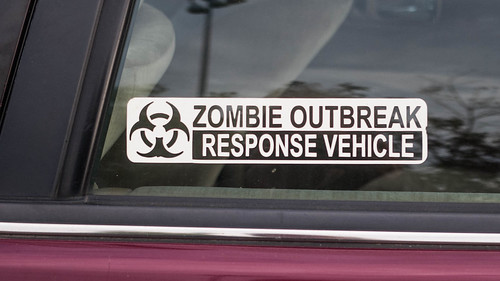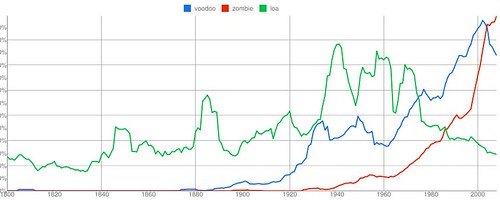I'd originally published this back in late October of 2011, at the time Occupy was active in Lower Manhattan. I'm reposting it here because Tim Sommers has an interesting post about Zombies in 3 Quarks Daily, though he doesn't mention the Voodoo background.
Last Friday afternoon I was walking up Manhattan’s Fifth Avenue when I was passed by a man and a woman, in each in zombie dress and makeup. Since I’d heard there was a zombie makeup booth down at Liberty Plaza (that is, Zucotti Park as renamed by Occupy Wall Street), I wondered whether they were coming from there. A couple weeks earlier I’d been to an anti-nuke rally where a woman was applying zombie makeup. Economist John Quiggin’s written Zombie Economics: How Dead Ideas Still Walk among Us and political scientist Dan Drezner has written Theories of International Politics and Zombies.
What’s up with zombies?
Yes, there’s all the movies. But we’re not talking about movies now. We’re talking about non-fiction books by ‘serious’ authors and we’re talking about people going about at least part of their lives in zombie drag.
Why?
Don’t really know, but I’ll chalk it up to chaotic times.
Now, look at this chart from Google’s Ngram Viewer (you can view the full chart here):
The red line tracks the occurrence of the word “zombie” and the blue line tracks the occurrence of “voodoo”. As you know voodoo is the Louisiana member of a family of New World religions that combine elements of West African animism with elements of Christianity. As such it is closely related to Santaria (Cuba) and, of course, Voudou (Haiti).
Zombies, as American popular culture has it, are one of the chief objects of Voodoo practice. Notice that the zombie (red) line lags behind the voodoo (blue) line until quite recently, when it crosses it just after the millennium. Zombie is now heading up while voodoo is heading down.
The lag between voodoo and zombie is easy to explain. Zombies—animated corpses—are at best a very minor feature of voodoo lore and practice. But they were featured in a 1932 feature film, White Zombie, and that, presumably, is what brought them into popular culture, where, as we all know, they’ve flourished. That “zombie” continues to be on the way up while “voodoo” is headed down might thus be taken as perhaps a final detachment of zombies from voodoo. Zombies now have lives of their own, as it were.
I note, in passing, that 1932, the pop culture birth of zombies, was a depression year, as are the current years, those of zombies ascendant. If you are a devotee of academic Marxism you may, if you so wish, insert some speculation about zombies as the cultural avatar of the death of capitalism—recall Quiggin’s Zombie Economics.
That’s two of the three lines in the graph. The third, the green line, is for “Loa.” Notice that it shows notable action in 1800 while neither of the others do—well, voodoo just a bit—and it peaks at about 1940 and then falls off in the 1970s. The Loas are the spirits of voodoo. Here’s the Wikipedia gloss:
They are also referred to as Mystères and the Invisibles, in which are intermediaries between Bondye (Bon Dieu, or good god)—the Creator, who is distant from the world—and humanity. Unlike saints or angels however, they are not simply prayed to, they are served. They are each distinct beings with their own personal likes and dislikes, distinct sacred rhythms, songs, dances, ritual symbols, and special modes of service. Contrary to popular belief, the loa are not deities in and of themselves; they are intermediaries for a distant Bondye.
Needless to say, the Loa are far more important in voodoo practice and lore than are zombies.
Zombies, I suspect, have more to do with white fears of black Others, than with voodoo as such. Except that now, as the graph seems to indicate, zombies have become detached from voodoo, which may mean that the notion has become detached from white fears of blacks.
But what do we make of that curve for “loa”? I don’t quite know. It might almost be an index of actual interest in and reference to voodoo as it is practiced as opposed to how it has been appropriated into the white imagination. But that’s just a crude guess.


"as the cultural avatar of the death of capitalism"
ReplyDeleteRousseau and the vampire. Not keen on marxist foundation legends but they do help jog you're memory.